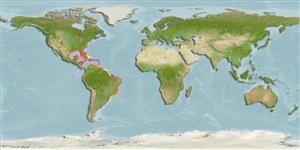>
Holocentriformes (Squirrelfishes, soldierfishes) >
Holocentridae (Squirrelfishes, soldierfishes) > Holocentrinae
Etymology: Sargocentron: Greek, sargos = sargus + Greek, kentron = sting (Ref. 45335).
Environment: milieu / climate zone / depth range / distribution range
Écologie
marin récifal; profondeur 33 - 110 m (Ref. 35505), usually ? - 82 m (Ref. 37108). Tropical
Western Atlantic: South Carolina (USA), Bermuda, Bahamas, northeastern Gulf of Mexico to Lesser Antilles (Ref. 7251), and southern Brazil (Ref. 47377).
Taille / Poids / Âge
Maturity: Lm ? range ? - ? cm
Max length : 13.0 cm SL mâle / non sexé; (Ref. 47377); common length : 13.0 cm TL mâle / non sexé; (Ref. 7251)
Épines dorsales (Total) : 11; Rayons mous dorsaux (Total) : 11 - 12; Épines anales: 4; Rayons mous anaux: 8. Usually ones small black spot present on tip of membrane between 1st and 2nd dorsal spines; nasal without spine (Ref. 13608). Snout spinules small, scales asymmetrical. Ridges on lower half of opercle numerous. Head and body salmon red with six very distinct white stripes (Ref. 37108).
Known from offshore , deep waters, with adults trawled between 33-110 m (Ref. 37108). Intertidal observations were also reported (Ref. 49162).
Life cycle and mating behavior
Maturities | Reproduction | Spawnings | Egg(s) | Fecundities | Larves
Smith-Vaniz, W.F., B.B. Collette and B.E. Luckhurst, 1999. Fishes of Bermuda: history, zoogeography, annotated checklist, and identification keys. American Society of Ichthyologists and Herpetologists Special Publication No. 4. 424 p. (Ref. 35505)
Statut dans la liste rouge de l'IUCN (Ref. 130435)
Menace pour l'homme
Harmless
Utilisations par l'homme
Outils
Articles particuliers
Télécharger en XML
Sources Internet
Estimates based on models
Preferred temperature (Ref.
123201): 19.5 - 27.4, mean 24.7 °C (based on 117 cells).
Phylogenetic diversity index (Ref.
82804): PD
50 = 0.5000 [Uniqueness, from 0.5 = low to 2.0 = high].
Bayesian length-weight: a=0.01622 (0.00774 - 0.03400), b=2.97 (2.80 - 3.14), in cm total length, based on LWR estimates for this Genus-body shape (Ref.
93245).
Niveau trophique (Ref.
69278): 3.5 ±0.5 se; based on size and trophs of closest relatives
Résilience (Ref.
120179): Haut, temps minimum de doublement de population inférieur à 15 mois (Preliminary K or Fecundity.).
Fishing Vulnerability (Ref.
59153): Low vulnerability (10 of 100).
Nutrients (Ref.
124155): Calcium = 83.2 [32.5, 335.8] mg/100g; Iron = 0.626 [0.249, 1.979] mg/100g; Protein = 18.4 [17.2, 19.6] %; Omega3 = 0.176 [0.074, 0.408] g/100g; Selenium = 37.6 [21.3, 74.7] μg/100g; VitaminA = 85.4 [31.9, 240.2] μg/100g; Zinc = 2.29 [0.95, 4.34] mg/100g (wet weight);
